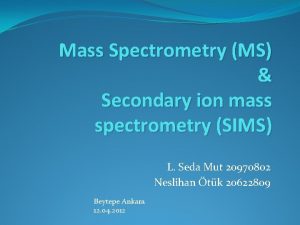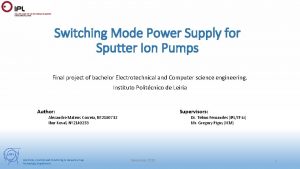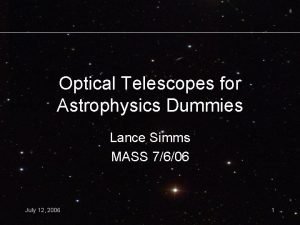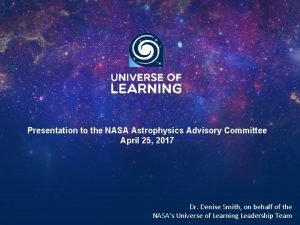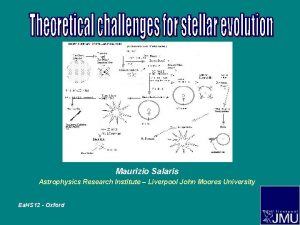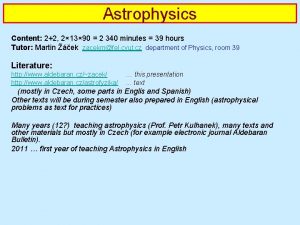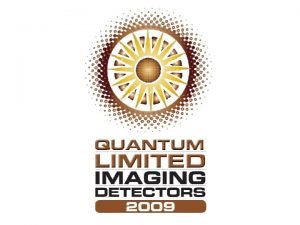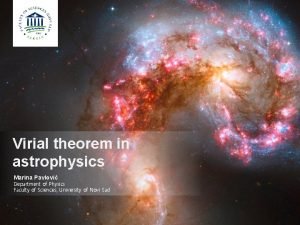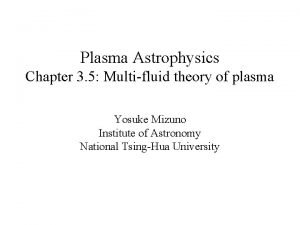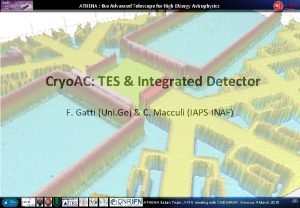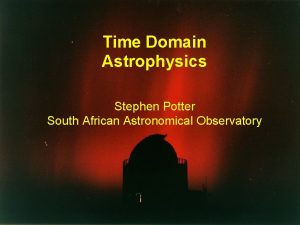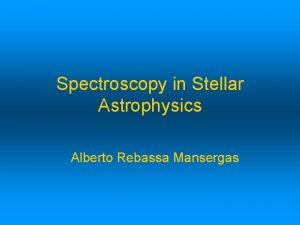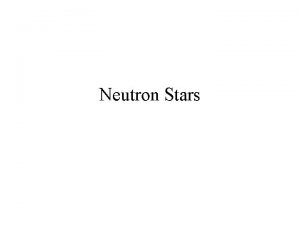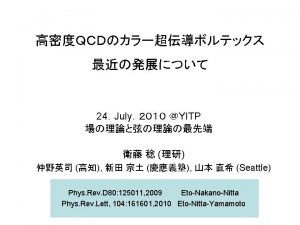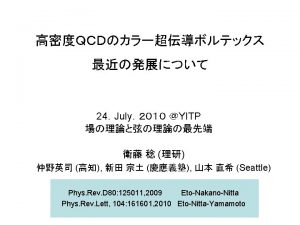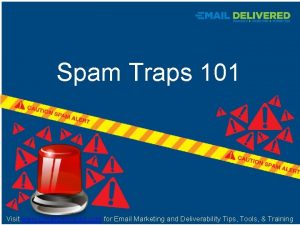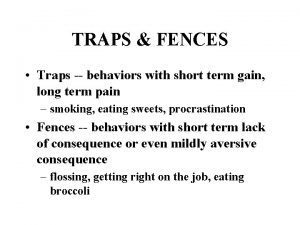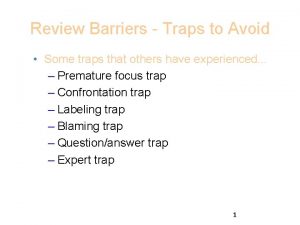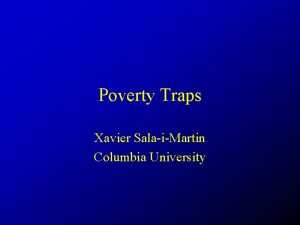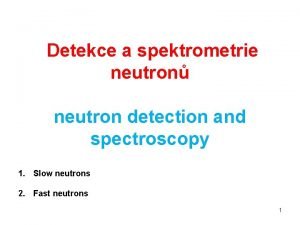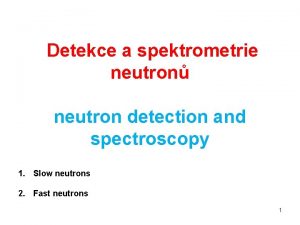Neutron Spectroscopy with Ion Traps for Astrophysics Working














- Slides: 14

Neutron Spectroscopy with Ion Traps for Astrophysics Working Group ATLAS/CARIBU User’s Meeting 2014 May 15, 2014 Nicholas Scielzo Experimental Nuclear Physics Group LLNL-PRES-? ? ? This work was performed under the auspices of the U. S. Department of Energy by Lawrence Livermore National Laboratory under contract DE-AC 52 -07 NA 27344. Lawrence Livermore National Security, LLC

Rapid neutron-capture process nucleosynthesis r process responsible for production of ~half heavy elements in very neutron-rich HED environments Abundance pattern extracted from Solar System and certain metal-poor stars in halo of galaxy Ø Neutrons added through successive rapid (n, g) reactions Ø Very neutron-rich isotopes are produced Ø At some point (n, g) is balanced by (g, n) until b decay occurs Ø At high enough masses, fission breaks up nuclei s b sta ility Lawrence Livermore National Laboratory ce o r p th a sp r- Peter Moller, LANL Final abundances determined from astrophysical conditions (n density, temp. ) and nuclear properties • Sn (masses) • β-decay half-lives • (n, g) cross sections • fission properties • b-delayed neutron emission (Pn) 2

b-delayed neutron impact on understanding rprocess nucleosynthesis stable nuclei At end of r process, exotic short-lived nuclei b decay back to stability During multiple decays, b-delayed neutron emission can change mass of nuclei ? Pn branching ratios influence final mass distribution Pn~40%? n r process path (very neutron rich!) Also provide additional neutrons during freeze out K. -L. Kratz et al. , Astron. Astrophys. 125, 381 (1983) Lawrence Livermore National Laboratory 3

New approach to neutron spectroscopy… without detecting neutrons Perform delayed-neutron spectroscopy by detecting recoiling daughter ions emerging from an ion trap b n b (1 Me. V): ~0. 01 ke. V recoil n (1 Me. V): ~10 ke. V recoil n Neutron emission Identify neutron emission from larger nuclear recoil. Avoid neutron detection. Need: Access to low-energy nuclear recoil Way to precisely measure recoil energies Efficient for any isotope with t 1/2 > 50 ms Lawrence Livermore National Laboratory Use ion trap… measure recoil energy from TOF 4

The Beta-decay Paul Trap • • • Works for any element Confine up to 105 -106 ions at once Hold for >200 sec Accessible half-life > 50 ms Confine in ~1 -mm 3 volume Lawrence Livermore National Laboratory 5

Outfit the Beta-decay Paul Trap with different radiation detectors Challenges • Trapping field perturbs ion trajectory • Ion cloud size Option: UCRL# 137 Xe* + b- + n 136 Xe + n MCP HPGe 136 Xe++ Plastic ΔE-E 137 I+ ec tr od es β n ν el Advantages • Measurement of both Pn and En • High efficiency and good En resolution • Insensitive to background g’s & n’s • Near-Gaussian En detector response • Efficiency nearly independent of En • Many checks of systematic effects 137 I Tr ap Principles • Trap bn precursors as ions • Cool by He gas to ~1 -mm 3 volume • Ions decay from rest at trap center • Trigger on β’s using plastic • Measure recoil time of flight (TOF) to MCP 1. β (+g) gives lower energy recoil (< 170 e. V) 2. β+n gives higher energy recoil (up to 14 ke. V) HPGe Your group 6

Data collected with 137 I+ beam of 30 ions/sec from an offline 1 -m. Ci 252 Cf source 137 I Counts/13 ns ions following neutron emission Counts/6. 5 ns 136 Xe b decay in the trap (Pn=7%) b-delayed neutron energy spectrum 137 Xe ions following b decay Time of flight (ms) Option: UCRL# Your group 7

Upgrades higher statistics and reduced systematic effects Increase b efficiency + spectroscopy HPGe = Plastic ΔE-E Tr a p el e ct ro de s 11 mm Plastic ΔE-E V HPGe V rf 85 MCP • • 2× DE-E plastic scintillators subtend ~10% Detector in rough vacuum separated from UHV by 10 -mm window Increase recoil-ion efficiency and improve measurement of En • • 2× 50 x 50 -mm 2 MCP subtend ~10% Position sensitivity (<1 mm) allows path length reconstruction Different b-ion angle combos Reduce En threshold better separation of b and bn recoils • Electrodes closer to center • RF applied only to ends of electrodes Option: UCRL# Your group 8

BPT moved down to the CARIBU Low-Energy Experimental Hall –Nov. -Dec. 2013 Measurement Campaign Ions/sec at BPT 102 -103 101 -102 ~101 144, 145 Cs 137, 138, 140 I 134, 135, 136 Sb PAD vvv. Name - Directorate/Department Name Option: UCRL# Your group 9

Analysis of this data is underway… 137 I 134 Sb calibration 144 Cs Option: UCRL# 138 I 135 Sb 140 I 136 Sb 145 Cs Your group 10

Design for a dedicated trap • Compact rod structure for electrodes minimize perturbation on recoil ions • Larger detector array (x 4 increase in coincident eff. vs. 2013) 4 MCPs, 8 ΔE-E plastic scintillators, 4 HPGe clovers Lawrence Livermore National • Laboratory Couple to a low-energy CARIBU beamline A. Levand (ANL) 11

Existing/future capabilities Proof-of. Principle (2011) Upgraded trap (2012 -2013) New ion trap (2015) Trap radius 17 mm 11 mm 7 mm Vrf 200 V 100 V ~30 V En resolution 10 -20% 5 -10% En threshold 200 ke. V 100 ke. V ~50 ke. V b threshold 150 ke. V 25 ke. V b-ion coinc. eff. 0. 04% 0. 7% 3% Sensitivity ~20 ions/s ~1 ion/sec ~0. 1 ion/s Lawrence Livermore National Laboratory 12

Ultimate reach of ion-trap approach is ~0. 1 ion/sec (any isotope shown in color) In addition to beam intensity, to reach most neutron-rich isotopes also need suppression of isobars by >102 Can collect high-quality data on isotopes near/on the r process path Option: UCRL# Your group 13

Ion Trap Collaborators Graduate Students Postdoctoral Researchers N. D. Scielzo, A. Czeszumska, E. B. Norman, S. Padgett, R. M. Yee, G. Savard, S. Caldwell, J. A. Clark, A. F. Levand, A. Perez Galvan, M. Burkey A. Aprahamian, S. Marley, N. Paul, S. Strauss, K. Siegl F. Buchinger, R. Orford R. Segel Lawrence Livermore National Laboratory C. J. Chiara, J. Harker K. S. Sharma, G. Morgan 14
 Applications of mass spectrometry
Applications of mass spectrometry Dipolo dipolo inducido
Dipolo dipolo inducido Fuerzas dipolo dipolo ejemplos
Fuerzas dipolo dipolo ejemplos Dispersion forces examples
Dispersion forces examples C6h12 fuerza intermolecular
C6h12 fuerza intermolecular Ion pump power supply
Ion pump power supply Astrophysics for dummies
Astrophysics for dummies Nasa astrophysics advisory committee
Nasa astrophysics advisory committee Liverpool astrophysics
Liverpool astrophysics Astrophysics syllabus
Astrophysics syllabus Rit astrophysics
Rit astrophysics Virial theorem in astrophysics
Virial theorem in astrophysics Astrophysics equations
Astrophysics equations Advanced telescope for high energy astrophysics
Advanced telescope for high energy astrophysics Time domain astrophysics
Time domain astrophysics
